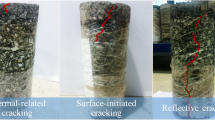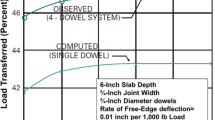Abstract
While widened slabs have been used to mitigate transverse cracking in jointed plain concrete pavements (JPCP), it is well-known that use of such slabs increases longitudinal cracking potential in JPCP. Field investigations have been conducted in Iowa widened JPCP and it was found that: (1) all longitudinal cracks are top-down cracks; (2) longitudinal cracks start mostly from transverse joints about 0.6–1.2 m (2–4 ft) away from widened slab edges (3) sites with a tied PCC shoulder exhibited fewer longitudinal cracks than sites constructed with hot mix asphalt (HMA) shoulders. In this paper, the longitudinal cracking mechanism of widened JPCP was demonstrated and longitudinal cracking potential was evaluated using numerical analysis. The critical load configuration with the highest longitudinal cracking potential for widened JPCP was identified. Three shoulder design alternatives were also compared in terms of their contributions to mitigation of longitudinal cracking potential. Compared to the use of a widened slab, the use of a regular size slab was found to be beneficial in mitigating longitudinal cracking at the cost of increasing transverse cracking potential. The findings of this study provide explanations as to where and how longitudinal cracking is likely to be initiated as well as recommendations as to how longitudinal cracking potential could be mitigated.
Similar content being viewed by others
References
R. Horonjeff, E. Bone, H.M. Westergaard, New Formulas For Stresses in Concrete Pavements of Airfields. Transactions, Discussion. Transactions of The American Society of Civil Engineers 113 (1948) 440–444.
NCHRP, Guide for Mechanistic-Empirical Design of New and Rehabilitated Pavement Structures, Champaign, IL., 2003.
R.E. Lederle, Development of a Longitudinal Cracking Fatigue Damage Model for Jointed Plain Concrete Pavements Using the Principles of Similarity, University of Minnesota, MN., 2014.
H. Ceylan, S. Kim, Y. Zhang, S. Yang, O. Kaya, K. Gopalakrishnan and P. Taylor, Prevention of Longitudinal Cracking in Iowa Widened Concrete Pavement. Final Report, IHRB Project TR-700. Iowa State University, 2018.
J.E. Hiller, J.R. Roesler, Determination of Critical Concrete Pavement Fatigue Damage Locations Using Influence Lines, J. Transp. Eng. 131(8) (2005) 599–607.
A.C. Heath, J.R. Roesler, J.T. Harvey, Modeling Longitudinal, Corner and Transverse Cracking in Jointed Concrete Pavements. Int. J. Pave. Eng. 4(1) (2003) 51–58.
J.E. Hiller, J.R. Roesler, Transverse Joint Analysis for use in Mechanistic-Empirical Design of Rigid Pavements, Transp. Res. Rec. 1089 (2002) 42–51.
S. Kim, H. Ceylan and K. Gopalakrishnan, Finite Element Modelling of Environmental Effects on Rigid Pavement Deformation, Frontiers Struc. Civ. Eng. J. 8(2) (2014) 101–114.
L. Khazanovich, Structural Analysis of Multi-Layered Concrete Pavement Systems, (Ph.D. Thesis), University of Illinois, Urbana, IL., 1994.
F. Mu, J. Vandenbossche, Evaluation of the Approach used for Modeling the Base under Jointed Plain Concrete Pavements in the AASHTO Pavement ME Design Guide, Int. J. Pave. Res. Tech. 9(4) (2016) 264–269.
FHWA, Compilation of Existing State Truck Size and Weight Limit Laws, Washington DC., 2015.
Iowa DOT, Iowa Truck Information Guide, July 2017–July 2018 Edition, 2018.
Iowa DOT, Iowa DOT Office of Design, Road Design Details — Typical Components, 2018.
Acknowledgements
The authors would like to thank the Iowa Department of Transportation (DOT) for sponsoring this research. The project’s Technical Advisory Committee (TAC) members, Ben Behnami, Chris Brakke, Vanessa Goetz, Todd Hanson, Kevin Merryman and Jason Omundson of Iowa DOT; Jacob Thorius of Washington County, Iowa; Greg Mulder of Iowa Concrete Paving Association (ICPA); Gordon Smith of ISU CP Tech Center and John Cunningham of Snyder & Associates, Inc. are gratefully acknowledged for their guidance. The contents of this paper reflect the views of the authors who are responsible for the facts and accuracy of the data presented within. The contents do not necessarily reflect the official views and policies of the Iowa DOT. This paper does not constitute a standard, specification, or regulation.
Author information
Authors and Affiliations
Corresponding author
Additional information
Peer review under responsibility of Chinese Society of Pavement Engineering.
Rights and permissions
About this article
Cite this article
Kaya, O., Zhang, Y., Ceylan, H. et al. Numerical analysis of longitudinal cracking in widened jointed plain concrete pavement systems. Int. J. Pavement Res. Technol. 12, 277–287 (2019). https://doi.org/10.1007/s42947-019-0034-z
Received:
Revised:
Accepted:
Published:
Issue Date:
DOI: https://doi.org/10.1007/s42947-019-0034-z




